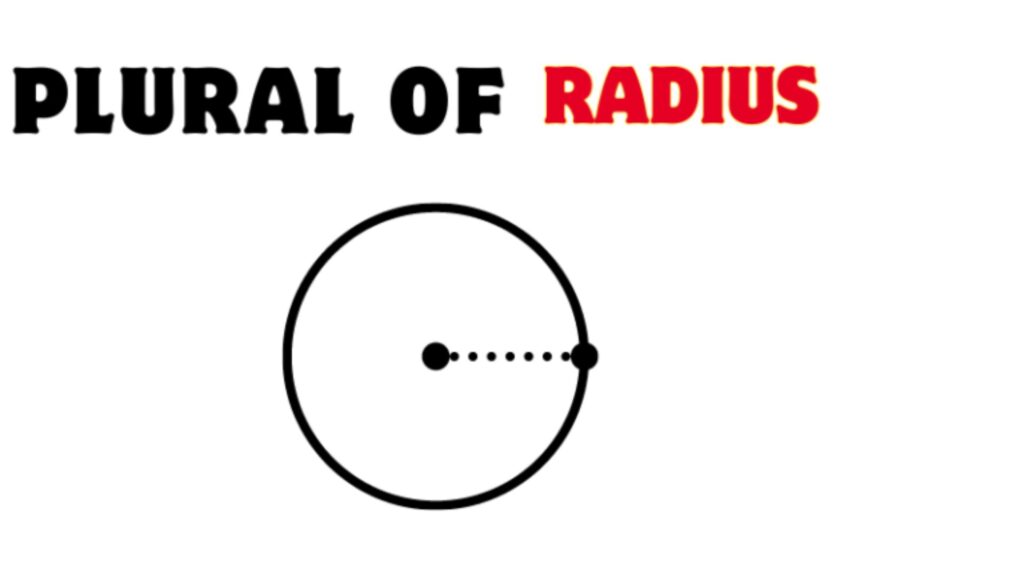If you’ve ever paused mid-sentence wondering whether to write radii or radiuses, you’re not alone. The word radius, borrowed from Latin, has two accepted plural forms in English. Knowing how to use radius plural correctly depends on the context, audience, and whether you’re writing formally or casually. Let’s break this down step by step, with examples and real-world scenarios.
What Is the Plural Form of Radius?

The plural of radius can be either radii (the classical Latin form) or radiuses (the anglicized modern version).
- Radii is more common in scientific, mathematical, and technical writing.
- Radiuses is used in everyday English, especially outside formal or academic contexts.
For example:
- ✅ In geometry class, we measured the radii of several circles.
- ✅ The new wheelchair design allows for tighter turning radiuses in narrow hallways.
Both are correct, but their usage depends on formality.
The Latin Roots: Why Two Plurals Exist
The word radius comes from Latin, where nouns ending in –us typically form plurals ending in –i (e.g., cactus → cacti, fungus → fungi). This explains radii.
However, as English evolved, many Latin-derived words also gained regularized plural forms, like radiuses, aligning with typical English pluralization rules.
Clear Rules & Patterns for Radius Plural Form
Here’s how to decide between radii and radiuses:
- Use “radii” in formal, academic, mathematical, or scientific writing.
- Use “radiuses” in general English, casual conversation, or when referring to everyday contexts like driving or construction.
- Both forms are acceptable, but don’t mix them in the same document.
Scenario Example 1: Academic Email Using “Radii”
Here’s how you might use radii in a formal email:
Subject: Updated Geometry Lab Results
Hi Professor Lang,
I’ve attached the lab report with the calculated radii for each circle. You’ll see that the average radius measured 5 cm, consistent across all samples.
Best regards,
Megan Reed
This example suits academic contexts where precision and formality matter.
Scenario Example 2: Workplace Email Using “Radiuses”
Now compare it to this workplace email:
Subject: Turning Radiuses for Delivery Trucks
Hi Carlos,
The new parking lot design needs a review. The turning radiuses for our delivery trucks might be too tight near the loading dock. Could you run the specs again?
Thanks,
James Porter
Here, radiuses feels natural because it’s in a practical, non-academic setting.
Common Mistakes & Fixes
Here are frequent errors when using the plural form of radius:
❌ “The radiis are unequal in length.”
✅ Fix: Replace with radii (or radiuses in casual English).
❌ “We compared the radius of several wheels.”
✅ Fix: Use radii because you’re comparing more than one.
Quick Reference Table: Radius and Similar Latin Nouns
| Singular | Latin Plural (-i) | English Plural (-es) |
|---|---|---|
| Radius | Radii | Radiuses |
| Cactus | Cacti | Cactuses |
| Fungus | Fungi | Funguses |
| Alumnus | Alumni | Alumnuses |
| Syllabus | Syllabi | Syllabuses |
This table shows how Latin-derived nouns ending in –us can take either the classical –i or anglicized –es plural forms.
Practical Usage in Different Fields
Geometry and Mathematics:
In geometry, radii is standard:
- “The radii of concentric circles increase proportionally to the diameter.”
Engineering and Design:
In engineering, radiuses often appears:
- “The machinist produced pipes of varying radiuses.”
Everyday English:
When referring to turning circles or informal contexts, radiuses fits better:
- “The car’s tight turning radius is great for parking.”
- “This model has smaller turning radiuses than the previous version.”
Before & After Usage in Context
Here’s how switching between forms changes tone:
- Before (Informal): “We checked the radiuses of all the wheels.”
- After (Formal): “We measured the radii of each wheel to verify accuracy.”
The second sounds more precise and academic.
Is Radius Plural or Singular?

The word radius is always singular. Its plurals—radii or radiuses—refer to more than one radius.
For example:
- Singular: “The radius of this circle is 4 cm.”
- Plural: “The two radii intersect at a right angle.”
Final Tips for Using Radius Plural Form
- Match your context. Use radii for scientific writing and radiuses for general English.
- Stay consistent. Don’t switch between plurals in the same piece.
- Watch spelling errors. Avoid non-standard forms like radiis or radies.
Conclusion
Understanding how to use the plural form of radius helps you sound polished and precise. Remember: radii works best in academic or technical contexts, while radiuses feels natural in everyday language.
Whether you’re writing a geometry report, emailing about turning radiuses, or explaining a concept in casual speech, both forms are valid. The key is knowing your audience and applying the right form confidently.

